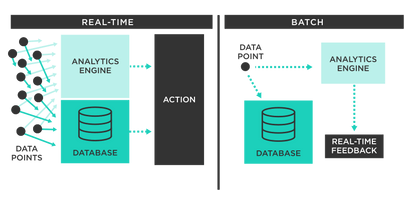The age-old debate between stream and batch processing has been a staple of data processing discussions for decades. While batch processing has its advantages, particularly in terms of simplicity and ease of implementation, stream processing has emerged as a more effective and efficient approach in many modern applications. In this article, we will explore five key ways in which stream processing outperforms batch processing, and examine the implications of this shift for businesses and organizations seeking to leverage the power of real-time data.
Key Points
- Stream processing enables real-time data analysis and decision-making
- Stream processing reduces latency and improves responsiveness
- Stream processing handles high-volume and high-velocity data streams
- Stream processing provides more accurate and up-to-date insights
- Stream processing enables more agile and adaptable business models
Real-Time Data Analysis and Decision-Making

One of the primary advantages of stream processing is its ability to analyze and process data in real-time, enabling businesses to make informed decisions quickly and respond to changing circumstances. This is particularly important in today’s fast-paced and highly competitive business environment, where the ability to adapt and respond to new information can be a key differentiator. By analyzing data streams as they are generated, businesses can identify trends, patterns, and anomalies, and take action to address them before they become major issues. For example, a company like Uber can use stream processing to analyze real-time traffic patterns and optimize its routing algorithms to minimize delays and improve the overall user experience.
Reduced Latency and Improved Responsiveness
Batch processing, on the other hand, involves collecting and processing large batches of data in periodic intervals, which can lead to significant latency and delays. This can be particularly problematic in applications where real-time responsiveness is critical, such as in financial trading or online gaming. Stream processing, by contrast, enables businesses to process and analyze data as it is generated, reducing latency and improving responsiveness. For instance, a company like Netflix can use stream processing to analyze user behavior and preferences in real-time, and provide personalized recommendations and content suggestions to improve the user experience.
| Processing Approach | Latency | Responsiveness |
|---|---|---|
| Batch Processing | High | Low |
| Stream Processing | Low | High |

Handling High-Volume and High-Velocity Data Streams

Another key advantage of stream processing is its ability to handle high-volume and high-velocity data streams, which are becoming increasingly common in today’s big data landscape. Batch processing can struggle to keep up with the sheer volume and velocity of modern data streams, leading to delays, errors, and other issues. Stream processing, on the other hand, is designed to handle high-volume and high-velocity data streams with ease, enabling businesses to analyze and process large amounts of data in real-time. For example, a company like Twitter can use stream processing to analyze millions of tweets per second and provide real-time insights and trends to its users.
More Accurate and Up-to-Date Insights
Stream processing also provides more accurate and up-to-date insights than batch processing, which can be critical in applications where data freshness and accuracy are paramount. By analyzing data streams in real-time, businesses can identify trends, patterns, and anomalies as they emerge, and take action to address them before they become major issues. This can be particularly important in applications such as financial trading, where the ability to respond quickly to changing market conditions can be the difference between profit and loss. For instance, a company like Goldman Sachs can use stream processing to analyze real-time market data and provide more accurate and up-to-date insights to its traders and investors.
Enabling More Agile and Adaptable Business Models
Finally, stream processing enables more agile and adaptable business models, which are critical in today’s fast-paced and rapidly changing business environment. By analyzing data streams in real-time, businesses can identify new opportunities and threats, and respond quickly to changing circumstances. This can be particularly important in applications such as online retail, where the ability to adapt quickly to changing consumer preferences and behaviors can be a key differentiator. For example, a company like Amazon can use stream processing to analyze real-time customer behavior and preferences, and provide personalized recommendations and content suggestions to improve the user experience.
What are the key advantages of stream processing over batch processing?
+The key advantages of stream processing over batch processing include real-time data analysis and decision-making, reduced latency and improved responsiveness, handling high-volume and high-velocity data streams, more accurate and up-to-date insights, and enabling more agile and adaptable business models.
How can businesses leverage the power of stream processing to gain a competitive edge?
+Businesses can leverage the power of stream processing to gain a competitive edge by analyzing data streams in real-time, identifying trends, patterns, and anomalies, and taking action to address them before they become major issues. This can be particularly important in applications such as financial trading, online retail, and social media, where the ability to respond quickly to changing circumstances can be a key differentiator.
What are the implications of stream processing for businesses and organizations seeking to leverage the power of real-time data?
+The implications of stream processing for businesses and organizations seeking to leverage the power of real-time data are significant. By analyzing data streams in real-time, businesses can gain a competitive edge, improve their responsiveness and agility, and make more informed decisions. This can be particularly important in today's fast-paced and data-driven world, where the ability to respond quickly to changing circumstances can be the difference between success and failure.
In conclusion, stream processing has emerged as a more effective and efficient approach to data processing in many modern applications. By analyzing data streams in real-time, businesses can gain a competitive edge, improve their responsiveness and agility, and make more informed decisions. As the volume and velocity of data streams continue to grow, the importance of stream processing will only continue to increase, and businesses that fail to adapt will risk being left behind. Whether you’re a business leader, a data scientist, or simply someone interested in the latest developments in data processing, it’s clear that stream processing is an area worth watching in the years to come.
